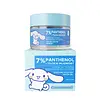What's inside
What's inside
 Key Ingredients
Key Ingredients

 Benefits
Benefits

 Concerns
Concerns

 Ingredients Side-by-side
Ingredients Side-by-side

Water
Skin ConditioningButylene Glycol
HumectantBetaine
HumectantPEG/PPG-17/6 Copolymer
SolventAcrylates/C10-30 Alkyl Acrylate Crosspolymer
Emulsion StabilisingArginine
Masking1,2-Hexanediol
Skin ConditioningPPG-5-Ceteth-20
EmulsifyingArtemisia Vulgaris Extract
Skin ConditioningCentella Asiatica Leaf Extract
Skin ConditioningPropylene Glycol
HumectantPanthenol
Skin ConditioningPEG/PPG-14/7 Dimethyl Ether
Skin ConditioningAllantoin
Skin ConditioningPentylene Glycol
Skin ConditioningCaprylhydroxamic Acid
Dipotassium Glycyrrhizate
HumectantPhenoxyethanol
PreservativeEthylhexylglycerin
Skin ConditioningAvena Sativa Kernel Extract
AbrasiveSodium Hyaluronate
HumectantLavandula Angustifolia Oil
MaskingLactobacillus/Soymilk Ferment Filtrate
Skin ConditioningPortulaca Oleracea Extract
Skin ConditioningMelaleuca Alternifolia Leaf Oil
AntioxidantAloe Barbadensis Leaf Juice Powder
Skin ConditioningGlyceryl Caprylate
EmollientMentha Piperita Oil
MaskingBeta-Glucan
Skin ConditioningWater, Butylene Glycol, Betaine, PEG/PPG-17/6 Copolymer, Acrylates/C10-30 Alkyl Acrylate Crosspolymer, Arginine, 1,2-Hexanediol, PPG-5-Ceteth-20, Artemisia Vulgaris Extract, Centella Asiatica Leaf Extract, Propylene Glycol, Panthenol, PEG/PPG-14/7 Dimethyl Ether, Allantoin, Pentylene Glycol, Caprylhydroxamic Acid, Dipotassium Glycyrrhizate, Phenoxyethanol, Ethylhexylglycerin, Avena Sativa Kernel Extract, Sodium Hyaluronate, Lavandula Angustifolia Oil, Lactobacillus/Soymilk Ferment Filtrate, Portulaca Oleracea Extract, Melaleuca Alternifolia Leaf Oil, Aloe Barbadensis Leaf Juice Powder, Glyceryl Caprylate, Mentha Piperita Oil, Beta-Glucan
Water
Skin ConditioningPanthenol
Skin ConditioningCentella Asiatica Extract
CleansingPropylene Glycol
HumectantGlycerin
HumectantArtemisia Vulgaris Extract
Skin ConditioningHordeum Vulgare Extract
EmollientAloe Barbadensis Leaf Extract
EmollientAnthemis Nobilis Flower Extract
MaskingMelaleuca Alternifolia Leaf Extract
PerfumingCeramide NP
Skin ConditioningSodium Hyaluronate Crosspolymer
HumectantSodium Hyaluronate
HumectantSodium Acetylated Hyaluronate
HumectantHyaluronic Acid
HumectantHydrolyzed Glycosaminoglycans
HumectantHydrolyzed Sodium Hyaluronate
Skin ConditioningHydrolyzed Hyaluronic Acid
HumectantPhenoxyethanol
PreservativeAcrylates/C10-30 Alkyl Acrylate Crosspolymer
Emulsion StabilisingTriethanolamine
Buffering1,2-Hexanediol
Skin ConditioningAmmonium Acryloyldimethyltaurate/Vp Copolymer
Disodium EDTA
PEG-7 Glyceryl Cocoate
EmulsifyingSodium Benzoate
MaskingPotassium Sorbate
PreservativeCitric Acid
BufferingPolysorbate 60
EmulsifyingBiosaccharide Gum-1
HumectantWater, Panthenol, Centella Asiatica Extract, Propylene Glycol, Glycerin, Artemisia Vulgaris Extract, Hordeum Vulgare Extract, Aloe Barbadensis Leaf Extract, Anthemis Nobilis Flower Extract, Melaleuca Alternifolia Leaf Extract, Ceramide NP, Sodium Hyaluronate Crosspolymer, Sodium Hyaluronate, Sodium Acetylated Hyaluronate, Hyaluronic Acid, Hydrolyzed Glycosaminoglycans, Hydrolyzed Sodium Hyaluronate, Hydrolyzed Hyaluronic Acid, Phenoxyethanol, Acrylates/C10-30 Alkyl Acrylate Crosspolymer, Triethanolamine, 1,2-Hexanediol, Ammonium Acryloyldimethyltaurate/Vp Copolymer, Disodium EDTA, PEG-7 Glyceryl Cocoate, Sodium Benzoate, Potassium Sorbate, Citric Acid, Polysorbate 60, Biosaccharide Gum-1
 Reviews
Reviews

Ingredients Explained
These ingredients are found in both products.
Ingredients higher up in an ingredient list are typically present in a larger amount.
1,2-Hexanediol is a synthetic liquid and another multi-functional powerhouse.
It is a:
- Humectant, drawing moisture into the skin
- Emollient, helping to soften skin
- Solvent, dispersing and stabilizing formulas
- Preservative booster, enhancing the antimicrobial activity of other preservatives
Acrylates/C10-30 Alkyl Acrylate Crosspolymer is a synthetic polymer. It is used to thicken and improve the texture of products. Due to its properties, it can prevent water and oil ingredients from separating.
Artemisia Vulgaris Extract is more commonly known as the common mugwort. It has strong antioxidant properties and helps soothe irritation.
Antioxidants protect skin from damage and the signs of aging.
This plant contains the compounds saponins, glycosides, flavanoids, protein, triterpenoids.
The common wugwort has been used in traditional Indian, Chinese, and European medicines to treat gastrointestinal diseases.
Learn more about Artemisia Vulgaris ExtractPanthenol is a common ingredient that helps hydrate and soothe the skin. It is found naturally in our skin and hair.
There are two forms of panthenol: D and L.
D-panthenol is also known as dexpanthenol. Most cosmetics use dexpanthenol or a mixture of D and L-panthenol.
Panthenol is famous due to its ability to go deeper into the skin's layers. Using this ingredient has numerous pros (and no cons):
Like hyaluronic acid, panthenol is a humectant. Humectants are able to bind and hold large amounts of water to keep skin hydrated.
This ingredient works well for wound healing. It works by increasing tissue in the wound and helps close open wounds.
Once oxidized, panthenol converts to pantothenic acid. Panthothenic acid is found in all living cells.
This ingredient is also referred to as pro-vitamin B5.
Learn more about PanthenolPhenoxyethanol is a preservative that has germicide, antimicrobial, and aromatic properties. Studies show that phenoxyethanol can prevent microbial growth. By itself, it has a scent that is similar to that of a rose.
It's often used in formulations along with Caprylyl Glycol to preserve the shelf life of products.
Propylene Glycol is an odorless, colorless liquid. As a humectant, it helps skin retain moisture. It also aids in delivering active ingredients.
Another role of this ingredient is preventing a product from melting or freezing. Propylene glycol also adds antimicrobrial properties to a product, elongating product lifespan.
This ingredient is considered an organic alcohol and commonly added into both cosmetics and foods.
Those with sensitive skin or conditions may develop a rash when using this ingredient.
Learn more about Propylene GlycolSodium Hyaluronate is hyaluronic acid's salt form. It is commonly derived from the sodium salt of hyaluronic acid.
Like hyaluronic acid, it is great at holding water and acts as a humectant. This makes it a great skin hydrating ingredient.
Sodium Hyaluronate is naturally occurring in our bodies and is mostly found in eye fluid and joints.
These are some other common types of Hyaluronic Acid:
Learn more about Sodium HyaluronateWater. It's the most common cosmetic ingredient of all. You'll usually see it at the top of ingredient lists, meaning that it makes up the largest part of the product.
So why is it so popular? Water most often acts as a solvent - this means that it helps dissolve other ingredients into the formulation.
You'll also recognize water as that liquid we all need to stay alive. If you see this, drink a glass of water. Stay hydrated!
Learn more about Water